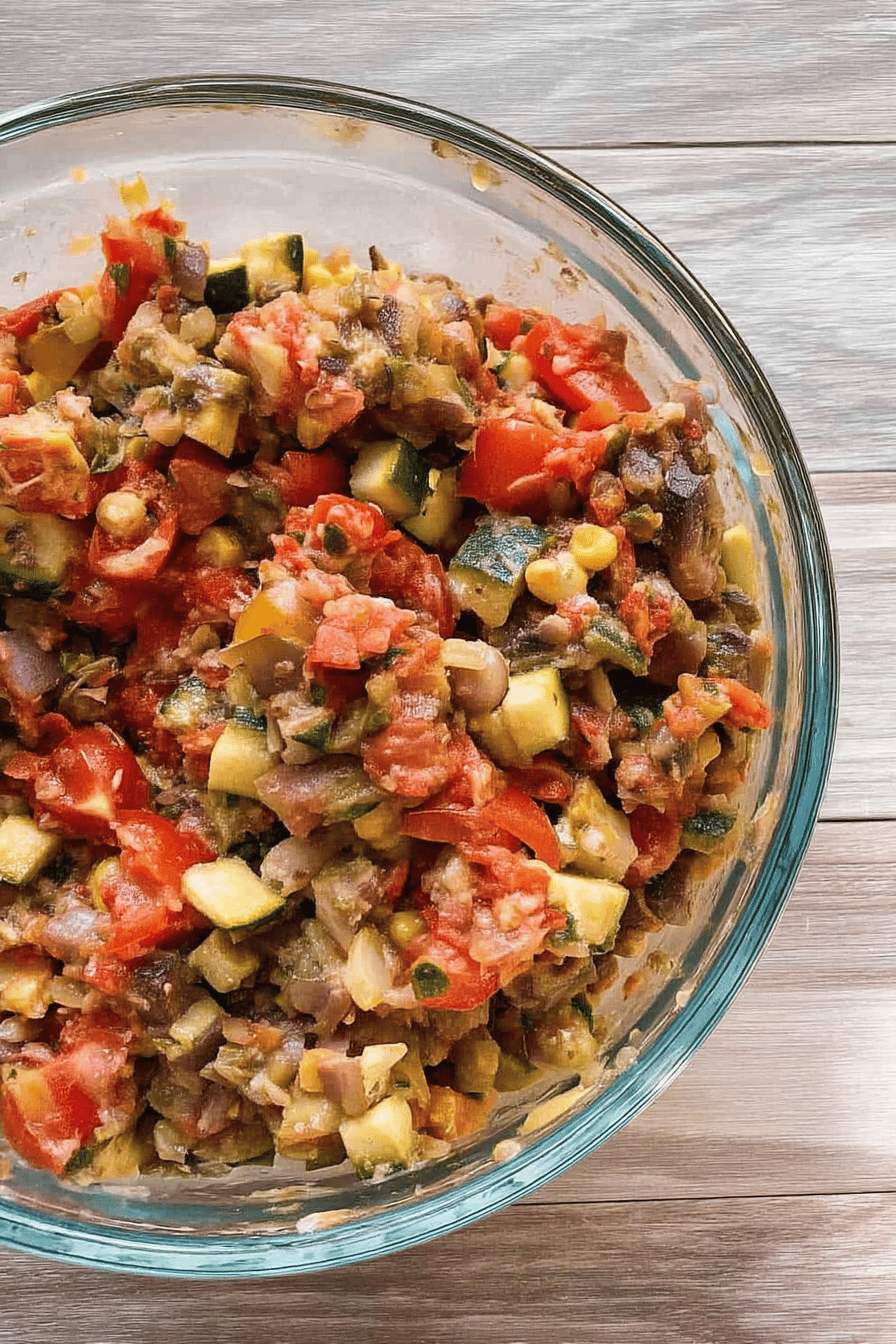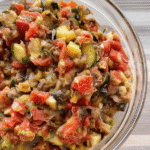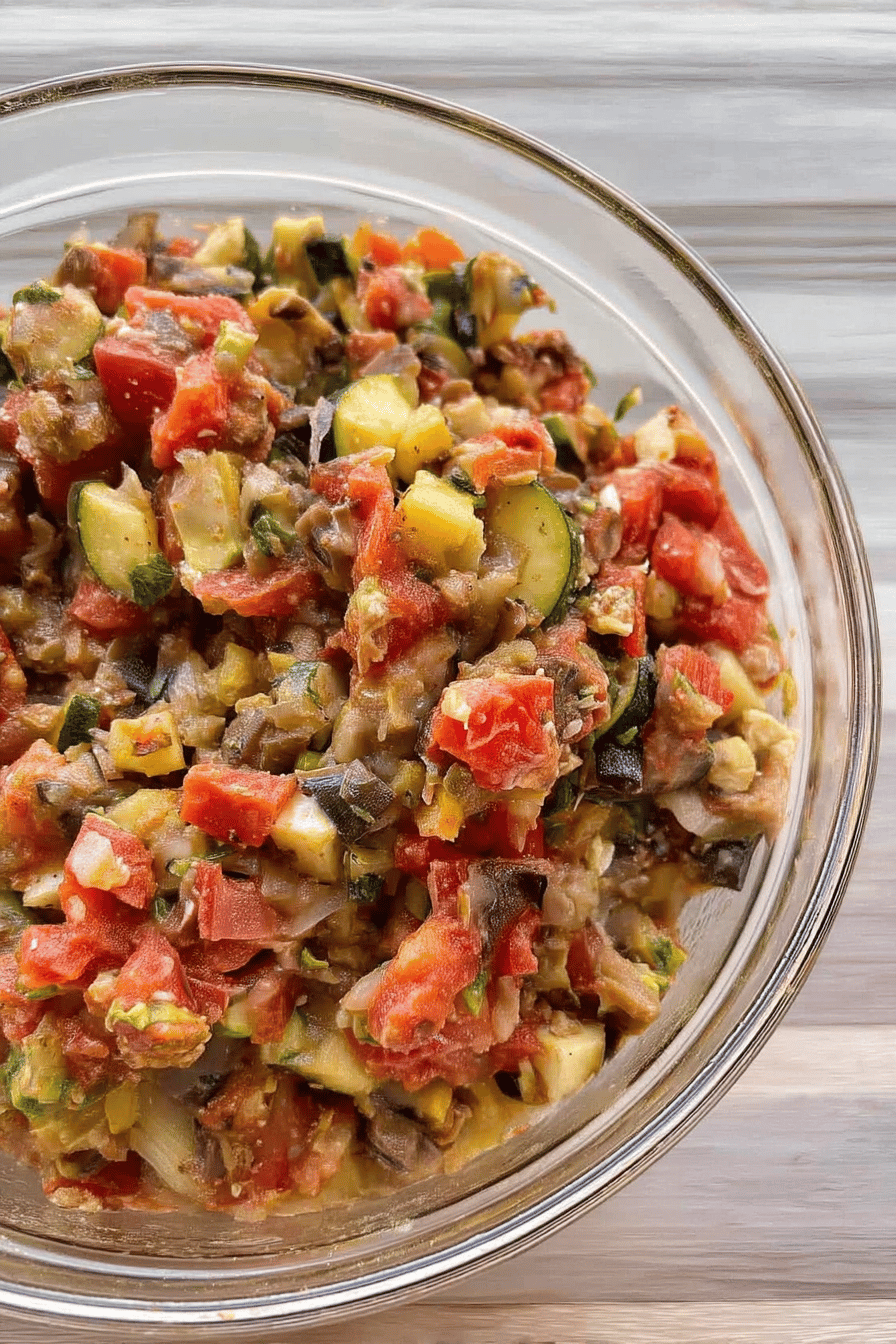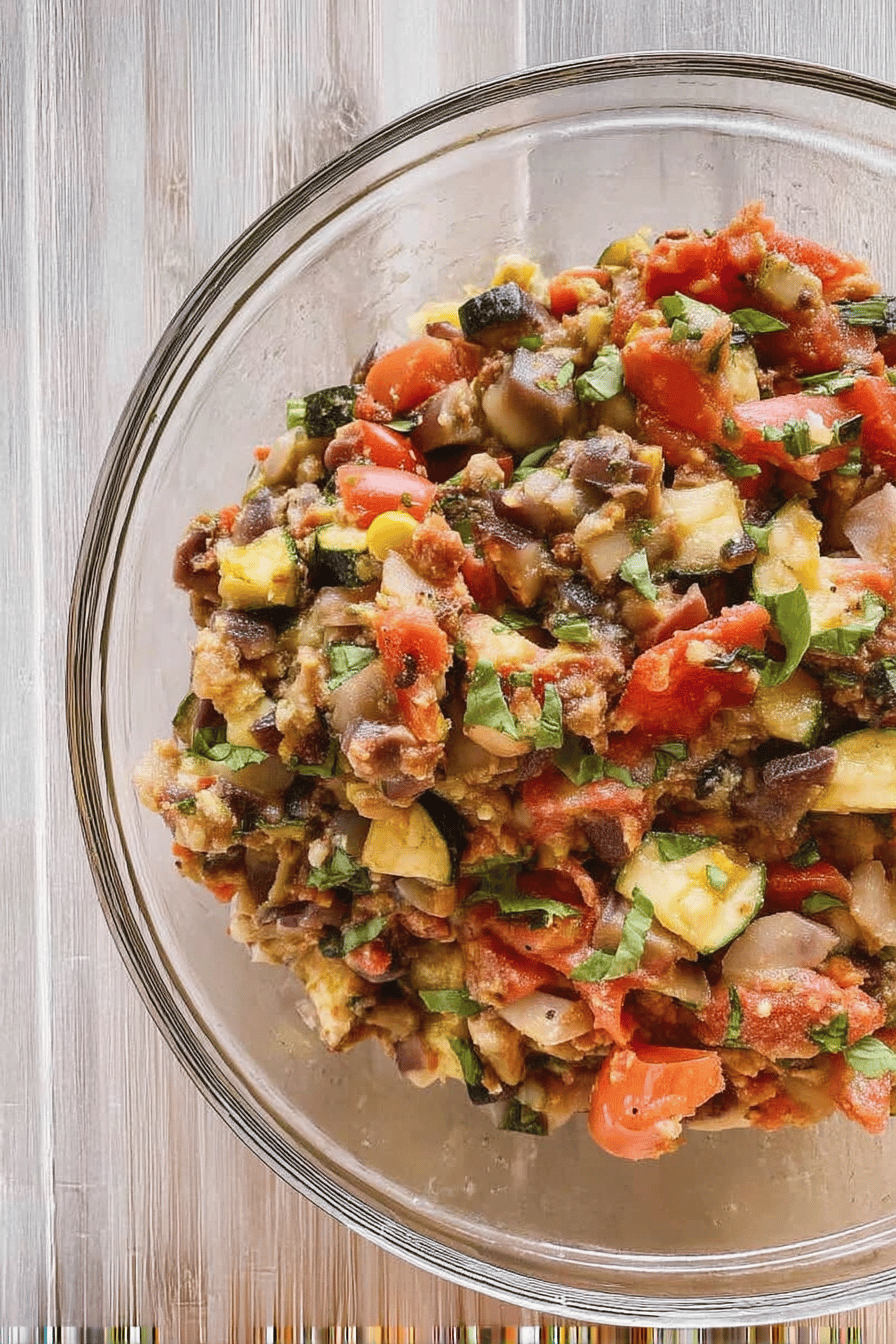Why You’ll Love This caponata
- Ease of preparation: This caponata recipe is delightfully simple and quick, ideal for busy weeknights or spontaneous dinners. The straightforward steps, including roasting eggplant and sautéing vegetables, come together in under an hour, letting you enjoy a flavorful Sicilian vegetable relish without fuss.
- Health benefits: Full of nutrient-dense ingredients like eggplant, tomatoes, celery, and olives, this caponata dish provides dietary fiber, antioxidants, and essential vitamins that support overall wellness. It is naturally low in unhealthy fats and rich in plant-based nutrients, making it a nourishing choice for balanced meals.
- Versatility: Caponata easily adapts to a range of dietary preferences. It’s naturally vegan and gluten-free, with options to adjust oil and sugar amounts for lower calorie needs. Serve it as a savory appetizer on toasted bread, a side for grilled meats or fish, or even as part of a vibrant vegetarian main course.
- Distinctive flavor: This recipe’s beautiful harmony of sweet, sour, and savory notes makes caponata unforgettable. The interplay of roasted eggplant, tangy vinegar, briny olives, and a hint of sweetness from raisins and honey creates a complex Mediterranean taste that tantalizes the palate.
Jump To
- 1. Why You’ll Love This caponata
- 2. Essential Ingredients for caponata
- 3. How to Prepare the Perfect caponata: Step-by-Step Guide
- 4. Dietary Substitutions to Customize Your caponata
- 5. Mastering caponata: Advanced Tips and Variations
- 6. How to Store caponata: Best Practices
- 7. FAQs: Frequently Asked Questions About caponata
- 8. caponata
Essential Ingredients for caponata
- 1 large globe eggplant (about 1 ¼ lb or ~570 g), cut into 1-inch cubes – the creamy base absorbing surrounding flavors
- 1 yellow onion, chopped – adds aromatic sharpness and depth
- 1 red bell pepper, cored and chopped – contributes sweetness and vibrant color
- 2 small celery stalks, thinly sliced – provides crispness and subtle bitterness
- 1 cup (240 ml) crushed canned tomatoes or 2 cups (480 ml) tomato sauce – adds natural acidity and richness
- ¼ cup pitted green olives, roughly chopped (such as Castelvetrano) – introduces briny, savory flavor
- 2 tablespoons capers, rinsed and drained – enhances tangy and salty dimensions
- ¼ cup raisins – adds a touch of natural sweetness
- 2 teaspoons honey (adjust to taste) or 1 tablespoon white sugar (optional) – balances acidity with sweetness
- 1 bay leaf – imparts herbal depth during cooking
- ¼ to ½ teaspoon crushed red pepper flakes (optional) – provides mild heat
- ¼ cup (60 ml) red wine vinegar or balsamic vinegar (4-6 tablespoons as alternative) – delivers characteristic sourness
- ¼ cup (60 ml) dry white wine or substitute with additional vinegar – adds complexity to sauce
- 2 tablespoons chopped fresh parsley – fresh herbal finish
- 2 tablespoons chopped fresh mint (optional) – gives a refreshing bright note
- Extra virgin olive oil for roasting and cooking (approximately 3-4 tablespoons total) – richness and proper cooking medium
- Salt and black pepper to taste – enhances and balances all flavors
Special Dietary Options
- Vegan: This traditional caponata is naturally plant-based and free from animal products.
- Gluten-free: All ingredients used are gluten-free, making caponata suitable for gluten-intolerant individuals.
- Low-calorie: Reduce olive oil quantity and swap sugar with natural sweeteners like honey or omit for a lighter dish.
How to Prepare the Perfect caponata: Step-by-Step Guide
First Step: Prepare and Salt Eggplant
Start by washing and cutting 1 large globe eggplant into 1-inch cubes. Sprinkle generously with salt and place in a colander for 20 to 30 minutes to draw out bitterness and excess moisture. After salting, rinse the cubes and pat them dry thoroughly with paper towels. This process is crucial to avoid bitterness and yields a tender texture in your caponata.
Second Step: Roast Eggplant
Preheat your oven to 400°F (200°C). Toss the dried eggplant cubes with 2 to 3 tablespoons of extra virgin olive oil and spread them evenly on a baking sheet. Roast for 25 to 30 minutes, turning once halfway through, until they are golden brown and tender. Roasting brings out the eggplant’s natural sweetness and reduces oil absorption compared to frying.
Third Step: Sauté Onions, Bell Peppers, and Celery
While the eggplant roasts, heat 1 tablespoon of olive oil in a large skillet over medium heat. Add 1 chopped yellow onion, 1 cored and chopped red bell pepper, and 2 thinly sliced celery stalks. Sauté for about 5 to 7 minutes until softened and lightly browned, seasoning with salt and pepper to build flavor depth for your caponata.
Fourth Step: Add Tomatoes, Olives, Capers, and Seasonings
Stir into the skillet 1 cup crushed canned tomatoes or 2 cups tomato sauce, ¼ cup roughly chopped pitted green olives, 2 tablespoons rinsed capers, ¼ cup raisins, 2 teaspoons honey (or 1 tablespoon white sugar), 1 bay leaf, and optional crushed red pepper flakes. Pour in ¼ cup red wine vinegar and ¼ cup dry white wine (or additional vinegar). Mix well and simmer gently for 8 to 10 minutes to marry the savory, sweet, and sour flavors.
Fifth Step: Combine Roasted Eggplant and Simmer
Add the roasted eggplant cubes to the skillet, stirring to combine. Let the mixture cook together for another 2 to 3 minutes, allowing all flavors to meld. Remove the bay leaf, then taste and adjust seasoning with salt, pepper, additional vinegar, or honey as desired. Stir in 2 tablespoons each of chopped fresh parsley and optional fresh mint for a vibrant fresh finish just before serving.
Final Step: Serve and Enjoy
Serve caponata at room temperature or slightly chilled. It pairs wonderfully as a relish on toasted Italian bread like ciabatta, or alongside grilled chicken, fish, or as part of a flavorful vegetarian spread. Caponata tastes best after resting for at least one hour or even overnight in the fridge to develop its complex flavors fully.
Tip: Adjust the use of vinegar and sugar based on your tomato’s natural acidity and sweetness for the perfect balance every time.
Dietary Substitutions to Customize Your caponata
Protein and Main Component Alternatives
- Swap eggplant with zucchini or roasted bell peppers for a lighter vegetable base or different texture.
- Add grilled tofu or tempeh cubes for extra plant-based protein while maintaining a vegan dish.
- Pair caponata with grilled chicken or fish for a complete meal with added protein.
Vegetable, Sauce, and Seasoning Modifications
- Replace celery with fennel or green beans for a unique crunch and flavor.
- Use balsamic vinegar instead of red wine vinegar for a milder, sweeter acidity.
- Switch fresh herbs from parsley and mint to basil or oregano for different flavor nuances.
- Add pine nuts or chili flakes to layer in crunch or heat.
These substitutions allow you to tailor the caponata recipe based on ingredient availability, seasonality, or dietary needs without losing the essence of its Mediterranean flavor.
Mastering caponata: Advanced Tips and Variations
Roasting eggplant instead of frying reduces oil absorption and enhances caramelized flavor, a pro method for richer caponata.
- Pro cooking techniques: Consider roasting eggplant with careful turning for even caramelization. Deglaze the skillet with white wine to capture all flavors before adding liquids.
- Flavor variations: Add toasted pine nuts or golden raisins for contrasting textures, or a dash of chili flakes for subtle heat. Try sherry vinegar for nuanced acidity.
- Presentation tips: Serve caponata in glossy bowls garnished with fresh herbs and toasted breadcrumbs for crunchy contrast and appealing look.
- Make-ahead options: Prepare caponata a day ahead to let flavors mellow and meld. Store chilled in sealed containers for easy, flavorful meal components.
How to Store caponata: Best Practices
| Storage Method | Guidelines |
|---|---|
| Refrigeration | Store caponata in an airtight container in the refrigerator for up to 5 days, preserving flavor and freshness. |
| Freezing | Freeze portions in freezer-safe containers for up to 3 months. Thaw overnight in the fridge before serving. |
| Reheating | Gently reheat on the stovetop over low heat, stirring occasionally to maintain texture. Avoid microwaving to prevent uneven heating. |
| Meal Prep Tips | Make large batches of caponata, portion into individual containers, and refrigerate or freeze. This helps save time and provides ready-to-eat flavor-packed sides. |

FAQs: Frequently Asked Questions About caponata
What is caponata and what are its main ingredients?
Caponata is a traditional Sicilian eggplant dish that combines sweet, sour, and savory flavors. Its main ingredients include eggplant, onions, celery, bell peppers, tomatoes, olives, and capers. Additional elements often added are raisins for sweetness, vinegar for tanginess, and sometimes honey or toasted pine nuts. The mix is cooked to create a flavorful relish typically served at room temperature.
How do you prepare eggplant for caponata to avoid bitterness?
To reduce bitterness, cube the eggplant and sprinkle it lightly with salt. Let it sit for about 20-30 minutes to draw out moisture and bitterness. Afterward, rinse and pat the cubes dry before roasting or sautéing. Roasting the eggplant at 400°F for 25-30 minutes with olive oil brings out its sweetness and creates a tender texture ideal for caponata.
Can caponata be served hot, cold, or at room temperature?
Caponata is versatile and can be served hot, cold, or at room temperature. It is most commonly enjoyed at room temperature, which allows the flavors to meld fully. Serving it chilled is refreshing, while warming it slightly enhances its comforting qualities. It’s often used as a topping on bread or as a side dish with meats and fish.
How long does caponata keep in the refrigerator and what is the best way to store it?
Caponata can be stored in an airtight container in the refrigerator for up to five days. For longer storage, it freezes well in a sealed container for several months. Before serving, bring it back to room temperature to restore its best flavor and texture. Proper storage helps maintain its balanced taste and freshness.
What dishes pair well with caponata?
Caponata pairs well with a variety of dishes. It is excellent as a relish on crusty bread or crostini for an appetizer. It complements grilled or roasted meats such as chicken and pork, and fish dishes like baked sea bass. It can also be served alongside pasta or as a flavorful addition to sandwiches and wraps, adding a bright, tangy contrast.

caponata
- Total Time: 50 minutes
- Yield: 6 servings 1x
- Diet: Vegetarian, Vegan
Description
🍆 Dive into the rich, tangy flavors of Caponata, a classic Sicilian eggplant relish bursting with sweet, savory, and acidic notes.
🥩🍤 Pairs beautifully with steak and shrimp stir fry, adding a bold Mediterranean twist to your meal.
Ingredients
1 large globe eggplant for the creamy base absorbing surrounding flavors
1 yellow onion for aromatic sharpness and depth
1 red bell pepper for sweetness and vibrant color
2 small celery stalks for crispness and subtle bitterness
1 cup crushed canned tomatoes or 2 cups tomato sauce for natural acidity and richness
1/4 cup pitted green olives for briny, savory flavor
2 tablespoons capers for tangy and salty dimensions
1/4 cup raisins for a touch of natural sweetness
2 teaspoons honey or 1 tablespoon white sugar for balancing acidity with sweetness
1 bay leaf for herbal depth during cooking
1/4 to 1/2 teaspoon crushed red pepper flakes for mild heat
1/4 cup red wine vinegar or balsamic vinegar for characteristic sourness
1/4 cup dry white wine for complexity to sauce
2 tablespoons chopped fresh parsley for fresh herbal finish
2 tablespoons chopped fresh mint for a refreshing bright note
Extra virgin olive oil for roasting and cooking
Salt and black pepper for enhancing and balancing all flavors
Instructions
First Step: Prepare and Salt EggplantStart by washing and cutting 1 large globe eggplant into 1-inch cubes. Sprinkle generously with salt and place in a colander for 20 to 30 minutes to draw out bitterness and excess moisture. After salting, rinse the cubes and pat them dry thoroughly with paper towels. This process is crucial to avoid bitterness and yields a tender texture in your caponata.
Second Step: Roast EggplantPreheat your oven to 400°F (200°C). Toss the dried eggplant cubes with 2 to 3 tablespoons of extra virgin olive oil and spread them evenly on a baking sheet. Roast for 25 to 30 minutes, turning once halfway through, until they are golden brown and tender. Roasting brings out the eggplant’s natural sweetness and reduces oil absorption compared to frying.
Third Step: Sauté Onions, Bell Peppers, and CeleryWhile the eggplant roasts, heat 1 tablespoon of olive oil in a large skillet over medium heat. Add 1 chopped yellow onion, 1 cored and chopped red bell pepper, and 2 thinly sliced celery stalks. Sauté for about 5 to 7 minutes until softened and lightly browned, seasoning with salt and pepper to build flavor depth for your caponata.
Fourth Step: Add Tomatoes, Olives, Capers, and SeasoningsStir into the skillet 1 cup crushed canned tomatoes or 2 cups tomato sauce, ¼ cup roughly chopped pitted green olives, 2 tablespoons rinsed capers, ¼ cup raisins, 2 teaspoons honey (or 1 tablespoon white sugar), 1 bay leaf, and optional crushed red pepper flakes. Pour in ¼ cup red wine vinegar and ¼ cup dry white wine (or additional vinegar). Mix well and simmer gently for 8 to 10 minutes to marry the savory, sweet, and sour flavors.
Fifth Step: Combine Roasted Eggplant and SimmerAdd the roasted eggplant cubes to the skillet, stirring to combine. Let the mixture cook together for another 2 to 3 minutes, allowing all flavors to meld. Remove the bay leaf, then taste and adjust seasoning with salt, pepper, additional vinegar, or honey as desired. Stir in 2 tablespoons each of chopped fresh parsley and optional fresh mint for a vibrant fresh finish just before serving.
Final Step: Serve and EnjoyServe caponata at room temperature or slightly chilled. It pairs wonderfully as a relish on toasted Italian bread like ciabatta, or alongside grilled chicken, fish, or as part of a flavorful vegetarian spread. Caponata tastes best after resting for at least one hour or even overnight in the fridge to develop its complex flavors fully.
Notes
🧂 Salting and resting the eggplant before cooking reduces bitterness and improves texture.
🔥 Roasting the eggplant provides a tender, caramelized texture without excess oil.
🍯 Taste and adjust vinegar and sweetness balance to achieve the perfect sweet and sour flavor.
- Prep Time: 15 minutes (plus 20-30 minutes for eggplant salting)
- Roasting and simmering time: 35 minutes
- Cook Time: 35 minutes
- Category: Appetizer / Side Dish
- Method: Roasting and Simmering
- Cuisine: Sicilian / Mediterranean
Nutrition
- Serving Size: 1/2 cup
- Calories: 120
- Sugar: 8 g
- Sodium: 500 mg (variable)
- Fat: 6 g
- Saturated Fat: 1 g
- Unsaturated Fat: 5 g
- Trans Fat: 0 g
- Carbohydrates: 14 g
- Fiber: 4 g
- Protein: 2 g
- Cholesterol: 0 mg
Keywords: Caponata, Steak, Shrimp, Sicilian Flavor



Your caponata recipe brought back memories of my nona’s kitchen! I love how the flavors meld together so beautifully. 🍆 Just a quick question — have you ever tried adding a splash of red wine vinegar? It might add a little extra zing!
★★★★★